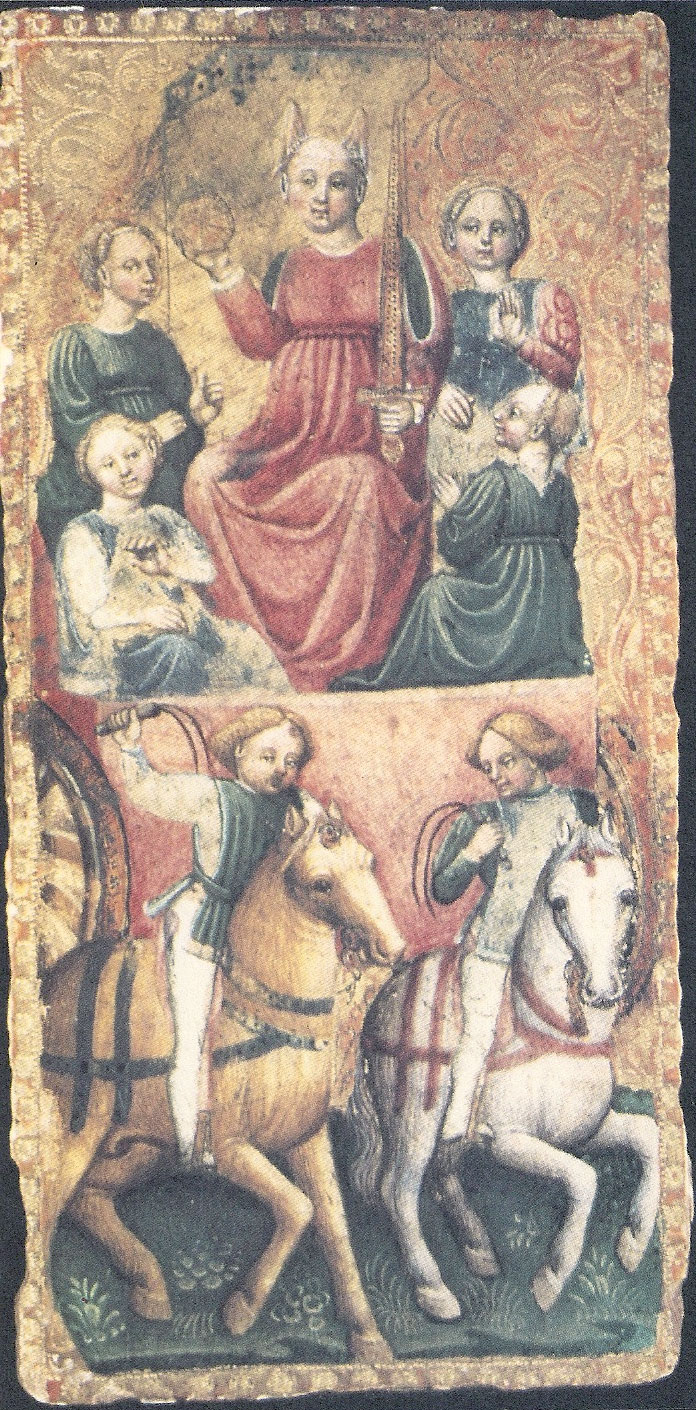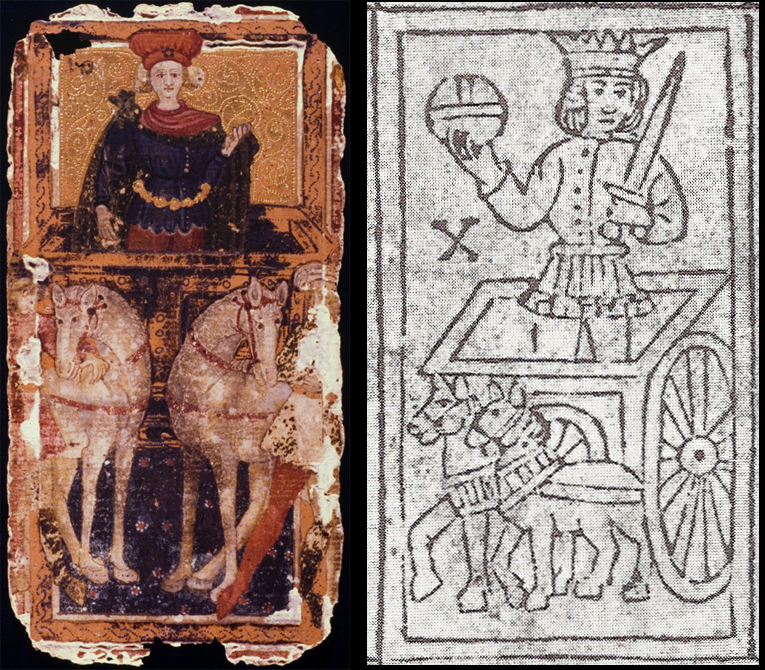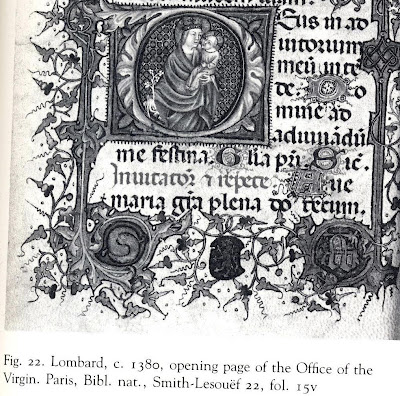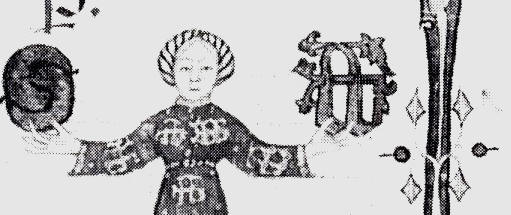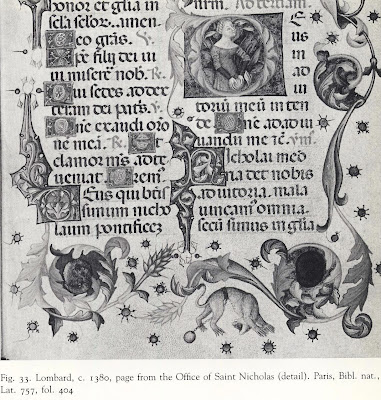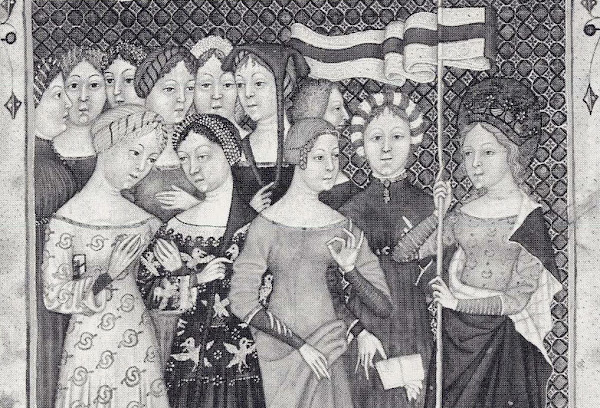On the Chastity vs. Dowry theme, it might be worth reading Kirsch. I cited a passage from her as a reason for seeing the CY Chariot card as both dowry and chastity at
viewtopic.php?f=11&t=906&p=13355&hilit=Count#p13355. Now I want to look at more of what Kirsch says, as I may not have given enough of it to show the key role played by something that is part of the emblem on the shield, as devised by Petrarch, not presently viewable on the card (although clear enough on other CY cards): the motto "A bon droyt." What is the historical context of that motto? I will let Kirsch speak for herself unedited, however tedious it is for me to type and for you to read (p. 19):
A dove against a blue sky and radiant sun was the personal emblem of Giangaleazzo Visconti, said to have been devised for him by Petrarch on the occasion of his first marriage, in 1360, at the age of nine, to Isabelle of Valois, who, as part of her dowry, brought Giangaleazzo the county of Vertus, in Champagne, together with the title Count of Virtues. A sentiment appropriate to this title--the motto "a buon droyt" (sometimes "a bon droit")--occasionally accompanies the sol-cum-columba motif. which figures prominently in the Florence Psalter-Hours (Fig. 41), the Coronation Missal (Fig. 3) and the Eulogy-Genealogy (Fig. 30), all three indubitably associated with Giangaleazzo (13).
In his Canzon morale fatta per la divisa del conte di Virtu of about 1389, the Visconti court poet Giovanni di Vannazzo explicates the emblem as follows: the radiant sun represents Giangaleazzo's power, reaching out to all; the dove symbolizes humility and chastity; the azure background denotes serenity. Each component, however, carries a second meaning: the sky evokes heaven, "loco del padre," the sun is Christ, and the dove the holy Ghost. (14)
Footnote 13. Petrarch claims to have suggested the device in a letter cited in Storia di Milano, v, 891. The device is described in the letter as "turtuem cum brevi notula a bon droit radiantis solis in medio" [a turtle dove with a short notation "a bon droit" in the middle of a radiant sun]. It is attributed to Petrarch also at the beginning of the poem by Giovanni di Vannozzo cited in note 14 below.
Footnote 14. Vannozzo's poem is published in Le rime di Francesco di Vannozzo, ed. A. Medin, Bologna 1928, 3-14. A bust-length representation of God the Father holding the orb of the universe, with the dove of the Holy Spirit and an enormous radiating sun beneath him, dominates the central window of the apse of the Cathedral of Milan. For the identification of this window motif with Giangaleazzo, see Annali, I, 249. As we shall see below (note 73), the carved boss at the keystone of the ribbing in the apse reiterates the theme of the Trinity.
So the phrase "a bon droyt" is part of the sun-and-dove motif as Petrarch described it in his letter. Kirsch says it refers to the title "Count of Virtues". His right to that title came as part of the dowry of Isabelle of Valois, as the title of the lord of the County of Vertus in France. (In 1387, incidentally he also got another right, to display the fleur-de-lys quartered with his own, in another marriage contract, that between Charles IV's brother Louis d"Orleans and Valentina Visconti (Kirsch p. 61)). (I would have you notice also that in the quote from Petrarch the bird is not a dove, i.e. a "columba", but a "turtuem", a different species with different symbolism; I will deal with this point later.)
Thus the theme of chastity appears at the very dawn of this Visconti symbol, with "a bon droit" implying the dowry, including the title "Count of Virtues" in two senses (as Count and as virtuous).
The association between chastity and dowries is reiterated in later Visconti marriage commemorations--again, the main theme is chastity, but the dowry is just behind the scene, in the context of St. Nicholas. At the risk of explaining the obscure with the obscure, I will start by quoting what Kirsch says about another Visconti device, two interlocking circles (p. 20):
A monogram consisting of interlaced initials and an emblem that has been descried previously as consisting of two interlocking circles or rings (Figs. 9, 22) are the most recurrent emblematic decoration in both Lat. 757 and Smith-Lesouef 22. Footnote: The emblem was described by Toesca as "due cerchi intrecciati" (1966, 131 n. 2). Leroquais (1927, I, 4) characterized it as "deux anneaux entrelaces."
Here are these illuminations (in the links they are larger):
http://4.bp.blogspot.com/-OC7EHQcKUCo/U ... g22DET.jpg
http://4.bp.blogspot.com/-O4m4j-IlAGA/U ... g9DET1.jpg
And the lady in Fig. 9 made larger:
After other examples and her theory about the monogram (she says it's a G and a V, but that is not critical for us), she says (p. 21f, and I highlight the relevant words):
The emblem in the right hand of the woman in Lat. 757 cannot be the interlocking circles or rings that it has been said to represent. As two small protruding ends clearly indicate, this emblem is in fact a knot. Joseph Krasa has shown that the omnipresent slipknots in the manuscripts of Wenceslaus IV were multivalent christological and imperial symbols that also stood for the bond of love between Wenceslaus and his wife Sophia. (26) I would suggest that the knots in the Paris Hours-Missals likewise signify several concerns of their owners, and that one of these was marriage.
From antiquity to our own time, knots have signified marriage, and in ancient Rome they came to symbolize the chastity of brides. (27) It is not fortuitous that in Lat. 757 the knot is given its most explicitly emblematic setting on the page for the mass of Saint Nicholas, guardian of the chastity of nubile maidens. (A full-page miniature of Nicholas providing dowries for three impoverished women who might otherwise have been condemned to prostitution introduces his mass on folio 363v.) In the lower border of folio 404, at Terce in the Office of Saint Nicholas, a monkey, symbol of lust, is controlled by a ball and chain, presumably under the influence of two flanking knots and a chaste woman in the initial above (Fig. 33). The woman is one of several who appear, only in this office, holding reddish-yellow balls that may allude to Saint Nicholas's gift.
Here is Fig. 33:
http://4.bp.blogspot.com/-NanEJgB2H7I/U ... hFig33.jpg
There is a vague similarity between reddish-yellow balls and the circular object that the woman in the CY Chariot cards holds. I will try to find more examples of this figure, hopefully in color.
I will skip the part where Kirsch talks about knots symbolizing marriage in other art of the time, e.g. the
Echecs amoureux, so as to go directly to another Visconti miniature with the same symbolism (p. 22f; this time the word "dowry" does not appear, but we have "acquired" in the context of marriage):
The object held by the heraldic figure on the page for the Mass of Saint Nicholas reappears as gold patterning on the white gown of one of Saint Ursula's companions on folio 380, in the miniature that introduces the Mass for Several Virgins (Fig. 11). If Lat. 757 was made for Giangaleazzo, the young woman whose gown is adorned with gold knots probably represents his bride of 1380, Caterina Visconti (it is even possible that the small book tucked under her arm refers to the smaller version of Lat. 757, Smith-Lesouef 22). Caterina links arms with a woman gowned in deep blue-black, embroidered with Giangaleazzo's principal emblem as Count of Virtues, white doves (here embroidered in pearls) springing from flamelike rays. It seems reasonable to suggest that she represents Isabelle, Giangaleazzo's first wife, through whom he acquired the county of Vertus in Champagne, with which the dove-and-sun emblem is associated. The Duke did after all direct in his will that effigies of each of his wives be placed at the sides of his tomb in the Certosa of Pavia. (30) In the miniature on folio 380, Saint Ursula herself wears a gown embellished with crescent moons, a reiteration of the theme of chastity.
Footnote 26. Krasa, 1971, 99-101. A slip-knotted cloth, like that of Wenceslaus, became a device of Giangaleazzo's son, Filippo Maria.
Footnote 27. On the symbolism of knots in antiquity, a. Pauly and G. Wissowa, Paulys Real-Encclopaedie der Classischen Altertumswissenschaft, XVII, I, Stuttgart, 1936, 803f., 808 (s.v. Nodus); C. Daremberg and E. Saglio, Dictionnaire des antiquities grecques et romains, IV, I, Paris, 1977, 88 (s.v. Nodus. Marriage was symbolized in antiquity by the knot of Hercules (also called a love-knot). For examples, see B. Segall, Katalog der Goldschmiede-Arbeiten (Museum Benaki, Athen), Athens, 1938, 32ff, Nos. 29, 30, and many others.
In Italian, the word nodo signified a marriage bond at least as early as the fourteenth century and was used as such by Petrarch (Vocabolario degli Accademici della Crusca, XI, 178 %xxxv).
Footnote 30. Corio, II, 969.
Here is the relevant part of Fig. 11 (you can see the whole at
http://4.bp.blogspot.com/-f6Icmjzm0qc/U ... g11DET.jpg)
So we have seen the theme of chastity in Visconti symbolism again, again linked with the theme of the dowry: first the County of Vertus and its title, then Saint Nicholas's gifts, and more weakly (just through the association of Isabella with the other ladies), in the illumination of St. Ursula. I don't think it is a question of which is primary and which secondary. St. Augustine had a theory of levels of interpretation as applied to the Bible. I think that something like that is going on here, from the most material (dowry) to the most spiritual (Holy Spirit).
You may ask, can we expect that whoever the cards were given to would know of these Visconti illuminations and what they meant? I think that the illuminations are merely surviving expressions of associations that people connected with the Visconti and Filippo in particular would have made it their business to know, at their peril.
Now for the bird. The dove as love, in relation to how the card embodies Petrarchan Chastity, it is conventional enough. There is the Holy Spirit as divine love, as I think Michael has remarked. Also, in Marziano's "game of the gods" the suit of Doves was headed by Venus, goddess of love (both chaste and unchaste). Venus's chariot was sometimes led by doves (e.g. Titian's "Venus and Adonis"). But in fact the bird is not a dove, a columba; it is turtuem, in English, turtledove. This bird is the one associated with the motto and the ray not only in the letter by Petrarch, but in a relevant song in French of the time by Johannes Ciconia. See http://books.google.com/books?id=dtE6F3 ... &q&f=false. I owe this reference to Cerulean at http://www.tarotforum.net/showpost.php? ... ostcount=7. For the connection to Giangaleazzo, see the pages in the book before and after.) The two birds had different symbolism. The turtuem was a symbol of faithfulness, i.e. chaste love (see http://en.wikipedia.org/wiki/European_Turtle_Dove). In Marziano's game, the suit of turtledoves was that of "virginities" (or continence, as Ross once translated it), with goddesses Pallas, Diana, and Vesta, and the nymph Daphne.
However, by Filippo's time some saw the bird as a dove, a columba. Marco quotes Decembrio as using that term in reference to the emblem (http://www.tarotforum.net/showthread.ph ... ost1987577). If Decembrio got it wrong, others may have as well. Whether Filippo would have made this mistake I don't know. As a dove, the bird symbolizes not only love, but other things relevant to the card, such as peace and innocence ("be ye wise as serpents and innocent as doves," http://bible.cc/matthew/10-16.htm, in Latin "simplices sicut columbæ," http://www.veritasbible.com/drb/compare ... thew_10:16). and peace. According to Wikipedia (http://en.wikipedia.org/wiki/Doves_as_symbols) they are also associated with Christian marriage.
In any case, Love is a strong association on the card in another way. The groom tending the horses would be seen as the same man as on the Love card, and the lady as the same as the lady there. In that connection, otice how the lady's scepter merges with the canopy of the chariot, so that the canopy's border looks like the blade of a scythe. Love is in front of her, and Death is behind, just as Petrarch said.

